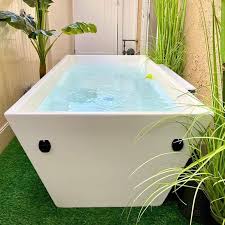Yes, inclusive design benefits everyone. Designing spaces with inclusivity in mind enhances usability, comfort, and convenience for all individuals, regardless of their abilities. It promotes a more equitable and inclusive society for everyone to enjoy.
“Explore the emerging field of wellness design in our article Wellness Design: Building Spaces for Health and Well-being, where we uncover the transformative power of creating environments that prioritize mental and physical well-being.”
In our increasingly urbanized world, reconnecting with nature has become essential for our well-being. Biophilic design offers a solution by incorporating natural elements and patterns into our built environments. This approach recognizes the innate human need to connect with nature and creates spaces that promote health, well-being, and productivity. In this article, we will explore the concept of biophilic design, its principles, benefits, and how it can transform spaces into healthy and harmonious environments.
Biophilic design is rooted in the belief that nature has a profound impact on our physical and mental well-being. By integrating natural elements, such as plants, water, and natural light, into our indoor spaces, we can create environments that mimic the beauty and tranquility of the natural world. Biophilic design not only enhances the aesthetics of our surroundings but also improves our overall health and happiness.
Biophilic design acknowledges the innate connection between humans and nature. It recognizes that exposure to nature reduces stress, improves cognitive function, and promotes a sense of calm and well-being. By bringing elements of nature into our surroundings, we can create spaces that support and nourish us.
Nature in the Space: Incorporating natural elements directly into the built environment, such as plants, water features, and natural materials.
Nature of the Space: Creating spaces that mimic natural patterns and processes, such as fractal geometries, organic shapes, and biomimicry.
Natural Analogues: Using materials, colors, and textures that evoke nature, even if they are not directly derived from it.
Nature of the Place: Designing spaces that are unique to their location, taking into consideration the local ecosystem, climate, and culture.
Human-Nature Connection: Fostering a sense of connection to nature through direct experiences, such as views of greenery, access to outdoor spaces, and the incorporation of natural light.
Natural light is a vital element of biophilic design. Maximizing daylight through large windows, skylights, and light wells not only reduces the need for artificial lighting but also connects us to the ever-changing beauty of the outdoors. Views of nature, whether it’s a lush garden or a scenic landscape, provide a sense of calm and serenity.
Incorporating indoor plants and living walls brings the vitality and beauty of nature indoors. Plants not only improve air quality by filtering pollutants but also create a sense of connection to the natural world. From small potted plants to vertical gardens, there are various ways to integrate greenery into our living and working spaces.
Choosing natural materials and textures helps evoke the essence of nature in our interiors. Wood, stone, bamboo, and other sustainable materials add warmth, texture, and a sense of authenticity to the space. From flooring to furniture, selecting natural materials contributes to a biophilic atmosphere.
Incorporating biophilic patterns and artwork inspired by nature further enhances the connection to the natural world. Designs inspired by leaves, flowers, or the intricate patterns found in natural ecosystems can be incorporated into wallpapers, textiles, and artwork, adding depth and visual interest to the space.
Water has a calming and soothing effect on our well-being. Integrating water features, such as fountains or indoor ponds, brings the sound and movement of water into our environments. The gentle sound of flowing water creates a sense of tranquility and can mask unwanted noise.
Colors play a significant role in biophilic design. Earth tones, shades of green, blues, and neutrals reflect the natural world and evoke a sense of calm and harmony. Using these colors in interior finishes, furnishings, and decor creates a cohesive and nature-inspired space.
Biophilic design has a positive impact on our mental well-being. Exposure to nature reduces stress, anxiety, and mental fatigue, while promoting relaxation, focus, and creativity. Biophilic spaces provide a refuge from the demands of daily life and foster a sense of calm and tranquility.
Bringing nature indoors has physical health benefits. Plants improve indoor air quality by reducing pollutants and increasing oxygen levels. Natural light enhances our circadian rhythm, promoting better sleep patterns and overall health. Being in nature-inspired environments can also boost our immune system and reduce the risk of illnesses.
Biophilic design positively impacts productivity and creativity. Studies have shown that access to nature and natural elements in the workspace enhances focus, problem-solving abilities, and overall productivity. The presence of greenery and natural light improves mood and energy levels, stimulating creativity and innovation.
Mudon DubaiIn residential settings, biophilic design creates homes that are tranquil, inviting, and conducive to well-being. From incorporating indoor gardens and natural light to designing outdoor spaces that seamlessly blend with the natural surroundings, biophilic design creates a sense of harmony and connection to nature in our homes.
Biophilic design has a significant impact on workplaces and offices. By incorporating elements such as green walls, natural lighting, and views of nature, companies can create environments that support employee well-being, satisfaction, and productivity. Biophilic design strategies can be applied to various office areas, including workstations, meeting rooms, and breakout spaces.
Biophilic design has proven benefits in healthcare settings. Incorporating elements such as healing gardens, natural light, and artwork inspired by nature creates a soothing and supportive environment for patients, reducing stress and promoting healing. It also benefits healthcare providers by improving job satisfaction and well-being.
To implement biophilic design, it’s important to prioritize nature from the outset of the design process. Consider how natural elements can be integrated into the space, such as incorporating greenery, natural light, and views of nature. Nature should be a central consideration in the layout, materials, and finishes chosen.
Integrate natural elements throughout the space, including plants, natural materials, and water features. Use organic shapes and patterns in the design, such as curved lines and fractal geometry. Incorporate elements like stone, wood, and natural textures to add depth and authenticity to the environment.
Biophilic design engages multiple senses to create a rich and immersive experience. Consider the sounds of water features, the scent of plants, and the tactile experience of natural materials. Engaging the senses deepens the connection to nature and enhances the overall well-being benefits of the space.
Implementing biophilic design may present challenges, such as limited space, maintenance requirements, or budget constraints. However, by working with experienced designers, seeking creative solutions, and prioritizing the integration of nature-inspired elements, these challenges can be overcome, resulting in spaces that nourish and uplift the human spirit.
Implementing biophilic design may present challenges, such as limited space, maintenance requirements, or budget constraints. However, by working with experienced designers, seeking creative solutions, and prioritizing the integration of nature-inspired elements, these challenges can be overcome, resulting in spaces that nourish and uplift the human spirit.
Biophilic design harnesses the healing power of nature to create spaces that enhance our health, well-being, and connection to the natural world. By incorporating natural elements, patterns, and processes into our built environments, we can create spaces that evoke calm, inspire creativity, and promote a sense of harmony. Embracing biophilic design allows us to create healthy and nurturing spaces that support our physical, mental, and emotional well-being.
Yes, biophilic design can be adapted to any size of space. Even small areas can benefit from incorporating elements such as indoor plants, natural light, and nature-inspired artwork to create a connection with nature.
The level of maintenance required for biophilic design depends on the specific elements incorporated. While living plants may require regular care, there are low-maintenance options available, such as resilient indoor plants and artificial greenery, that can still provide the benefits of biophilia with minimal upkeep.
Biophilic design can be applied to various environments, including residential, commercial, educational, and healthcare settings. The principles of biophilic design can be tailored to suit the specific needs and requirements of each space.
There are cost-effective ways to incorporate biophilic design, such as using potted plants, incorporating natural light through window treatments, and incorporating nature-inspired patterns and colors in the decor. Even small additions can have a significant impact on creating a biophilic atmosphere.
While there are no specific certifications solely for biophilic design, sustainability certifications like LEED (Leadership in Energy and Environmental Design) and WELL Building Standard include criteria related to biophilia. These certifications provide guidelines and standards for creating healthy and sustainable spaces, often incorporating elements of biophilic design.
In our fast-paced and stress-inducing modern lives, the importance of spaces that support our health and well-being cannot be overstated. Wellness design is an approach that focuses on creating environments that prioritize physical health, mental well-being, social connections, and environmental sustainability. In this article, we will explore the concept of wellness design and how it can transform spaces into sanctuaries that promote our overall wellness.
Wellness design goes beyond aesthetics and functionality; it aims to enhance our physical, mental, and emotional well-being through thoughtful design choices. It recognizes the profound impact that our environment has on our overall wellness and seeks to create spaces that support and nurture us.
Wellness design acknowledges the connection between our physical surroundings and our well-being. It recognizes that a well-designed space can contribute to stress reduction, productivity improvement, mood enhancement, and overall health.












You are welcome to share your ideas with us in comments.